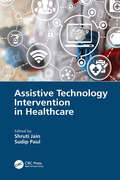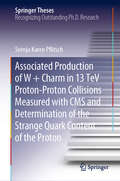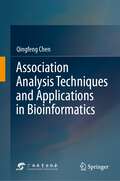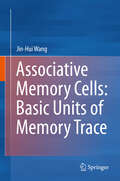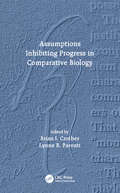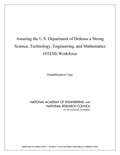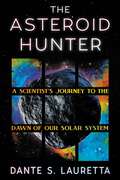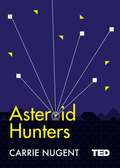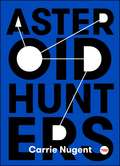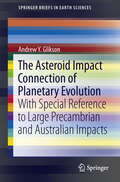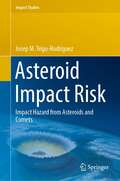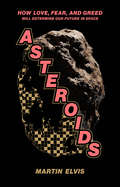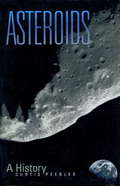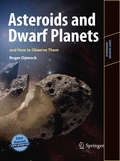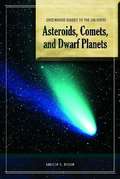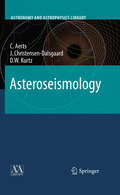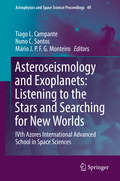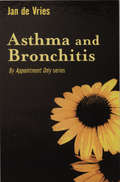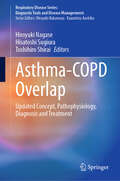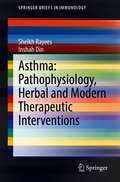- Table View
- List View
Assistive Technology Intervention in Healthcare
by Shruti Jain Sudip PaulAssistive Technology Intervention in Healthcare focuses on various applications of intelligent techniques in biomedical engineering and health informatics. It aims to create awareness about disability reduction and recovery of accidental disability with the help of various rehabilitative systems. Novel technologies in disability treatment, management and assistance, including healthcare devices and their utility from home to hospital, are described. The book deals with simulation, modeling, measurement, control, analysis, information extraction and monitoring of physiological data in clinical medicine and biology. Features Covers the latest evolutionary approaches to solve optimization problems in the biomedical engineering field Explains machine learning–based approaches to improvement in health engineering areas Reviews the IoT, cloud computing and data analytics in healthcare informatics Discusses modeling and simulations in the design of biomedical equipment Explores monitoring of physiological data This book is aimed at researchers and graduate students in biomedical engineering, clinical engineering and bioinformatics.
Associated Production of W + Charm in 13 TeV Proton-Proton Collisions Measured with CMS and Determination of the Strange Quark Content of the Proton (Springer Theses)
by Svenja Karen PflitschThe associated production of a W boson and a single charm quark (W+c) is the only process in proton-proton collisions that directly probes the strange quark content of the proton. In this thesis, W+charm production is measured in proton-proton collisions at the LHC at 13 TeV, as recorded by the Compact Muon Solenoid (CMS) experiment. The analysis focuses on the identification of W bosons in their leptonic decay to a muon and a neutrino and charm quarks are tagged via the full reconstruction of D*-Mesons.The measured cross sections of W+c production are used, in combination with other relevant CMS results and the most precise HERA DIS data, in a QCD analysis to determine the strange quark content of the proton. The resulting strange quark distribution and suppression, with respect to the other light sea quarks, are in good agreement with those obtained in neutrino scattering experiments and extend their kinematic reach.
Association Analysis Techniques and Applications in Bioinformatics
by Qingfeng ChenAdvances in experimental technologies have given rise to tremendous amounts of biology data. This not only offers valuable sources of data to help understand biological evolution and functional mechanisms, but also poses challenges for accurate and effective data analysis. This book offers an essential introduction to the theoretical and practical aspects of association analysis, including data pre-processing, data mining methods/algorithms, and tools that are widely applied for computational biology. It covers significant recent advances in the field, both foundational and application-oriented, helping readers understand the basic principles and emerging techniques used to discover interesting association patterns in diverse and heterogeneous biology data, such as structure-function correlations, and complex networks with gene/protein regulation. The main results and approaches are described in an easy-to-follow way and accompanied by sufficientreferences and suggestions for future research. This carefully edited monograph is intended to provide investigators in the fields of data mining, machine learning, artificial intelligence, and bioinformatics with a profound guide to the role of association analysis in computational biology. It is also very useful as a general source of information on association analysis, and as an overall accompanying course book and self-study material for graduate students and researchers in both computer science and bioinformatics.
Associative Memory Cells: Basic Units of Memory Trace
by Jin-Hui WangThis book focuses on associative memory cells and their working principles, which can be applied to associative memories and memory-relevant cognitions. Providing comprehensive diagrams, it presents the author's personal perspectives on pathology and therapeutic strategies for memory deficits in patients suffering from neurological diseases and psychiatric disorders. Associative learning is a common approach to acquire multiple associated signals, including knowledge, experiences and skills from natural environments or social interaction. The identification of the cellular and molecular mechanisms underlying associative memory is important in furthering our understanding of the principles of memory formation and memory-relevant behaviors as well as in developing therapeutic strategies that enhance memory capacity in healthy individuals and improve memory deficit in patients suffering from neurological disease and psychiatric disorders. Although a series of hypotheses about neural substrates for associative memory has been proposed, numerous questions still need to be addressed, especially the basic units and their working principle in engrams and circuits specific for various memory patterns. This book summarizes the developments concerning associative memory cells reported in current and past literature, providing a valuable overview of the field for neuroscientists, psychologists and students.
Assuming the Ecosexual Position: The Earth as Lover
by Annie Sprinkle Beth Stephens Jennie KleinThe story of the artistic collaboration between the originators of the ecosex movement, their diverse communities, and the Earth What&’s sexy about saving the planet? Funny you should ask. Because that is precisely—or, perhaps, broadly—what Annie Sprinkle and Beth Stephens have spent many years bringing to light in their live art, exhibitions, and films. In 2008, Sprinkle and Stephens married the Earth, which set them on the path to explore the realms of ecosexuality as they became lovers with the Earth and made their mutual pleasure an embodied expression of passion for the environment. Ever since, they have been not just pushing but obliterating the boundaries circumscribing biology and ecology, creating ecosexual art in their performance of an environmentalism that is feminist, queer, sensual, sexual, posthuman, materialist, exuberant, and steeped in humor.Assuming the Ecosexual Position tells of childhood moments that pointed to a future of ecosexuality—for Annie, in her family swimming pool in Los Angeles; for Beth, savoring forbidden tomatoes from the vine on her grandparents&’ Appalachian farm. The book describes how the two came together as lovers and collaborators, how they took a stand against homophobia and xenophobia, and how this union led to the miraculous conception of the Love Art Laboratory, which involved influential performance artists Linda M. Montano, Guillermo Gómez-Peña, and feminist pornographer Madison Young. Stephens and Sprinkle share the process of making interactive performance art, including the Chemo Fashion Show, Cuddle, Sidewalk Sex Clinics, and Ecosex Walking Tours. Over the years, they celebrated many more weddings to various nature entities, from the Appalachian Mountains to the Adriatic Sea. To create these weddings, they collaborated with hundreds of people and invited thousands of guests as they vowed to love, honor, and cherish the many elements of the Earth.As entertaining as it is deeply serious, and arriving at a perilous time of sharp differences and constricting categories, the story of this artistic collaboration between Sprinkle, Stephens, their diverse communities, and the Earth opens gender and sexuality, art and environmentalism, to the infinite possibilities and promise of love.
Assumptions Inhibiting Progress in Comparative Biology
by Brian I. Crother & Lynne R. ParentiThis book is a thought-provoking assessment of assumptions inhibiting progress in comparative biology. The volume is inspired by a list generated years earlier by Donn Rosen, one of the most influential, innovative and productive comparative biologists of the latter 20th century. His list has assumed almost legendary status among comparative evolutionary biologists. Surprisingly many of the obstructing assumptions implicated by Rosen remain relevant today. Any comparative biologist hoping to avoid such assumptions in their own research will benefit from this introspective volume.
Assuring the U.S. Department of Defense a Strong Science, Technology, Engineering, and Mathematics (STEM) Workforce
by National Research Council Committee on Science, Technology, Engineering, and Mathematics Workforce Needs for the U.S. Department of Defense and the U.S. Defense Industrial Base Board on Higher Education and Workforce Policy and Global Affairs National Academy of Engineering Division on Engineering and Physical SciencesThe ability of the nation's military to prevail during future conflicts, and to fulfill its humanitarian and other missions, depends on continued advances in the nation's technology base. A workforce with robust Science, Technology, Engineering and Mathematics (STEM) capabilities is critical to sustaining U.S. preeminence. Today, however, the STEM activities of the Department of Defense (DOD) are a small and diminishing part of the nation's overall science and engineering enterprise. Assuring the U.S. Department of Defense a Strong Science, Technology, Engineering, and Mathematics (STEM) Workforce presents five principal recommendations for attracting, retaining, and managing highly qualified STEM talent within the department based on an examination of the current STEM workforce of DOD and the defense industrial base. As outlined in the report, DOD should focus its investments to ensure that STEM competencies in all potentially critical, emerging topical areas are maintained at least at a basic level within the department and its industrial and university bases.
The Asteroid Hunter: A Scientist's Journey to the Dawn of our Solar System
by Dante LaurettaFEATURED IN THE NEW YORK TIMES, NPR&’S SCIENCE FRIDAY, THE WASHINGTON POST, AND SCIENCE MAGAZINE A &“brilliant account of a 21st century real-life fantasy&” (Sir Brian May) of space exploration and a lesson in fragility in the quest to return an asteroid sample and unlock the mystery of formation of life on earth, braided with the remarkable life story of the OSIRIS-REx mission leader, Dr. Dante Lauretta. On September 11, 1999, humanity made a monumental discovery in the vastness of space. Scientists uncovered an asteroid of immense scientific importance—a colossal celestial entity. As massive as an aircraft carrier and towering as high as the iconic Empire State Building, this cosmic titan was later named Bennu. Remarkable for much more than its size, Bennu belonged to a rare breed of asteroids capable of revealing the essence of life itself. But just as Bennu became a beacon of promise, researchers identified a grave danger. Hurtling through space, it threatens to collide with our planet on September 24, 2182. Leading the expedition was Dr. Dante Lauretta, the Principal Investigator of NASA's audacious OSIRIS-REx Asteroid Sample Return Mission. Tasked with unraveling Bennu's mysteries, his team embarked on a daring quest to retrieve a precious sample from the asteroid's surface — one that held the potential to not only unlock the secrets of life's origins but also to avert an unprecedented catastrophe. A tale of destiny and danger, The Asteroid Hunter chronicles the high-stakes mission firsthand, narrated by Dr. Lauretta. It offers readers an intimate glimpse into the riveting exploits of the mission and Dr. Lauretta's wild, winding personal journey to Bennu and back. Peeling back the curtain on the wonders of the cosmos, this enthralling account promises a rare glimpse into the tightly woven fabric of scientific exploration, where technical precision converges with humanity&’s profound curiosity and indominable spirit.
Asteroid Hunters (Ted Bks.)
by Carrie NugentDr Carrie Nugent is an asteroid hunter - one of the select group of scientists working diligently to map our cosmic neighbourhood. For the first time ever we are reaching the point where we may be able to prevent a natural disaster resulting from an asteroid collision. Nugent will delve into the impact asteroids have had in the past: the extinction of the dinosaurs, the earth-sized hole Shoemaker-Levy 9 left in Jupiter just a few years ago, how the surprise hit on Chelyabinsk in Russia could have started a war and unlucky Ms Anne Hodges - the only person (that we know of) in modern history to be the victim of a direct hit. Nugent will also reveal the cutting-edge work that she is part of - using NASA's NEOWISE telescope to track down near-Earth asteroids. NEOWISE has seen over 158,000 asteroids and discovered over 30,000. We will also get a rare glimpse into the work of this band of asteroid hunters and their techniques. Asteroid orbits are chaotic which means a small early change has a big impact later on. The successful hunt and mapping of asteroids could mean nothing less than saving life on Earth.
Asteroid Hunters (TED Books)
by Carrie NugentFor the first time, scientists could have the knowledge to prevent a natural disaster epic in scale—an asteroid hitting the earth and in this exciting, adventuresome book, Carrie Nugent explains how.What are asteroids, and where do they come from? And, most urgently: Are they going to hit the Earth? What would happen if one was on its way? Carrie Nugent is an asteroid hunter—part of a group of scientists working to map our cosmic neighborhood. For the first time ever, we are reaching the point where we may be able to prevent the horrible natural disaster that would result from an asteroid collision. In Asteroid Hunters, Nugent reveals what known impact asteroids have had: the extinction of the dinosaurs, the earth-sized hole Shoemaker Levy 9 left in Jupiter just a few decades ago, how the meteorite that bursted over Chelyabinsk in Russia could have started a war, and unlucky Ms. Anne Hodges—the only person (that we know of) in US history to be the victim of a direct hit. Nugent also introduces the telescope she uses to detect near-Earth asteroids. Ultimately, detection is the key to preventing asteroid impact, and these specialized scientists are working to prevent the unthinkable from happening. If successful, asteroid hunting will lead to the first natural disaster humans have the know-how and the technology to prevent. The successful hunt and mapping of asteroids could mean nothing less than saving life on earth.
The Asteroid Impact Connection of Planetary Evolution
by Andrew Y. GliksonWhen in 1981 Louis and Walter Alvarez, the father and son team, unearthed a tell-tale Iridium-rich sedimentary horizon at the 65 million years-old Cretaceous-Tertiary boundary at Gubbio, Italy, their find heralded a paradigm shift in the study of terrestrial evolution. Since the 1980s the discovery and study of asteroid impact ejecta in the oldest well-preserved terrains of Western Australia and South Africa, by Don Lowe, Gary Byerly, Bruce Simonson, Scott Hassler, the author and others, and the documentation of new exposed and buried impact structures in several continents, have led to a resurgence of the idea of the catastrophism theory of Cuvier, previously largely supplanted by the uniformitarian theory of Hutton and Lyell. Several mass extinction of species events are known to have occurred in temporal proximity to large asteroid impacts, global volcanic eruptions and continental splitting. Likely links are observed between asteroid clusters and the 580 Ma acritarch radiation, end-Devonian extinction, end-Triassic extinction and end-Jurassic extinction. New discoveries of ~3.5 - 3.2 Ga-old impact fallout units in South Africa have led Don Lowe and Gary Byerly to propose a protracted prolongation of the Late Heavy Bombardment (~3.95-3.85 Ga) in the Earth-Moon system. Given the difficulty in identifying asteroid impact ejecta units and buried impact structures, it is likely new discoveries of impact signatures are in store, which would further profoundly alter models of terrestrial evolution. .
Asteroid Impact Risk: Impact Hazard from Asteroids and Comets (Impact Studies)
by Josep M. Trigo-RodríguezThis book describes the complexity of impact hazards associated with asteroids and comets. The challenge in this regard lies in the heterogeneous nature of these bodies that endanger our planet, which is why we are conducting new experiments to better understand their unique physicochemical properties. Several generations of astronomers have tracked and mapped the orbits of asteroids and comets over the past few centuries, and telescopic surveys have only begun to discover “new” interstellar objects. In addition, cutting-edge software allow our computers to combine the orbits of these elusive bodies to study how they evolve over time and seek to match asteroid complexes as fragments of asteroidal and cometary disruptions.Impact hazards represent one of the greatest threats to the survival of human beings in the medium term. Geological studies show that the stratigraphic record holds clear geological evidence of these rare but transcendental encounters in the history of life on our planet. The study and quantification of past catastrophes can give us clues to face future challenges in the form of potential impacts.Further, it would be illogical to assume that Earth’s interaction with space is limited to major impacts. Every night, Earth is struck by millions of particles, and dozens of meteor showers occur around the globe every year. The study of lake and ocean sediments reveals the magnitude of the continuous contribution of interplanetary matter reaching Earth: roughly 100,000 tons per year.Accordingly, the goal of this book is to underscore the need for society-wide awareness of the dangers associated with asteroid and comet impacts, on the basis of scientific evidence and with no intention of sparking alarmism. After all, we ourselves may only be the fruit of an opportunity given to mammals sixty-five million years ago to evolve after the conflagration that would be the downfall of the dinosaurs. If we have learned to read Earth’s geological history, we should consider ourselves a very fortunate species, and its teachings should equip us to face this problem.The also book emphasizes the role of space missions to gain insights on these bodies, particularly describing the relevance of the DART (NASA) and Hera (ESA) missions to deflect and study Dimorphos, respectively, the small satellite of the Didymos binary asteroid.
Asteroid, Meteoroid, and Comet Facts (Into Reading, Level T #76)
by Bruce NaylorNIMAC-sourced textbook
The Asteroid Threat
by William E. BurrowsPresents a realistic, workable plan for defusing a potentially lethal threat from a rogue asteroid or comet. The explosion of a large meteor over Chelyabinsk, Siberia, in February 2013 is just the latest reminder that planet Earth is vulnerable to damaging and potentially catastrophic collisions with space debris of various kinds. In this informative and forward-looking book, veteran aerospace writer William E. Burrows explains what we can do in the future to avoid far more serious impacts from "Near-Earth Objects" (NEOs), as they are called in the planetary defense community. The good news is that humanity is now equipped with the advanced technology necessary to devise a long-term strategy to protect the planet. Burrows outlines the following key features of an effective planetary defense strategy: * A powerful space surveillance system capable of spotting a serious threat from space at least twenty-five years in advance* A space craft "nudge" that would throw a collision-course asteroid off target long before it poses the threat of imminent impact * A weapons system to be used as a last-ditch method to blast an NEO should all else fail.The author notes the many benefits for world stability and increasing international cooperation resulting from a united worldwide effort to protect the planet. Combining realism with an optimistic can-do attitude, Burrows shows that humanity is capable of overcoming a potentially calamitous situation.From the Trade Paperback edition.
Asteroids: How Love, Fear, and Greed Will Determine Our Future in Space
by Martin ElvisA unique, wide-ranging examination of asteroid exploration and our future in space Human travel into space is an enormously expensive and unforgiving endeavor. So why go? In this accessible and authoritative book, astrophysicist Martin Elvis argues that the answer is asteroid exploration, for the strong motives of love, fear, and greed. Elvis’s personal motivation is one of scientific love—asteroid investigations may teach us about the composition of the solar system and the origins of life. A more compelling reason may be fear—of a dinosaur killer–sized asteroid hitting our planet. Finally, Elvis maintains, we should consider greed: asteroids likely hold vast riches, such as large platinum deposits, and mining them could provide both a new industry and a funding source for bolder space exploration. Elvis explains how each motive can be satisfied, and how they help one another. From the origins of life, to “space billiards,” and space sports, Elvis looks at how asteroids may be used in the not-so-distant future.
Asteroids
by Curtis PeeblesAsteroids suggest images of a catastrophic impact with Earth, triggering infernos, tidal waves, famine, and death -- but these scenarios have obscured the larger story of how asteroids have been discovered and studied. During the past two centuries, the quest for knowledge about asteroids has involved eminent scientists and amateur astronomers, patient research and sudden intuition, advanced technology and the simplest of telescopes, newspaper headlines and Cold War secrets. Today, researchers have named and identified the mineral composition of these objects. They range in size from 33 feet to 580 miles wide and most are found in a belt between the orbits of Mars and Jupiter.Covering all aspects of asteroid investigation, Curtis Peebles shows how ideas about the orbiting boulders have evolved. He describes how such phenomena as the Moon's craters and dinosaur extinction were gradually, and by some scientists grudgingly, accepted as the results of asteroid impacts. He tells how a band of icy asteroids rimming the solar system, first proposed as a theory in the 1940s, was ignored for more than forty years until renewed interest and technological breakthroughs confirmed the existence of the Kuiper Belt. Peebles also chronicles the discovery of Shoemaker-Levy 9, a comet with twenty-two nuclei that crashed into Jupiter in 1994, releasing many times the energy of the world's nuclear arsenal.Showing how asteroid research is increasingly collaborative, the book provides insights into the evolution of scientific ideas and the ebb and flow of scientific debate.
Asteroids
by Michael K. ShepardWhere do asteroids come from and what are they made of? What clues do they hold about the evolution of the Solar System? Scientists have catalogued hundreds of thousands of asteroids, and many are thought to contain water and amino acids, the building blocks of life. Michael K. Shepard tells the fascinating story of their discovery, and what they can tell us about the history of our own planet. He describes how we find and study asteroids, what they look like through the eyes of powerful telescopes and spacecraft, and plans for future sample return missions. This timely book interweaves accessible scientific explanations with historical background and personal narrative, providing an engaging read for anyone curious about asteroids and what they may mean for our future - both as threats and opportunities.
Asteroids and Dwarf Planets and How to Observe Them (Astronomers' Observing Guides)
by Roger DymockDwarf planets (which were formerly called asteroids except for the planet Pluto), and the smaller Solar System bodies still called asteroids today, are making front page news, particularly those that are newly discovered and those that might present a hazard to life on Earth by impacting our planet. In this age of giant telescopes and space probes, these small Solar System bodies have advanced from being tiny points of light to bodies worthy of widespread study. This book describes the dwarf planets and asteroids themselves, their origins, orbits, and composition, and at how amateur astronomers can play a part in their detection, tracking, and imaging. The book is divided into two parts. Part I describes physical properties (including taxonomic types) of dwarf planets and asteroids, how they formed in the early life of the Solar System, and how they evolved to their present positions, groups, and families. It also covers the properties used to define these small Solar System bodies: magnitude, rotation rates (described by their light-curves), and orbital characteristics. Part II opens with a description of the hardware and software an amateur or practical astronomer needs to observe and also to image asteroids. Then numerous observing techniques are covered in depth. Finally, there are lists of relevant amateur and professional organizations and how to submit your own observations to them.
Asteroids, Comets, and Dwarf Planets
by Andrew Rivkin Andrew S. RivkinA working astronomer, Rivkin looks at the smallest bodies in the solar system, providing readers with the most current information about asteroids, comets, and dwarf planets (including Pluto). Written with students in mind, the book describes how such small bodies form, what they are made of, and what kind of atmospheres they might have. It also discusses whether any of these bodies--especially asteroids--present a danger to spacecraft or to the earth. Featuring many illustrations and an extensive glossary of astronomical terms, this lively book will interest almost anyone who wants to know more about the solar system. Annotation c2009 Book News, Inc., Portland, OR (booknews.com)
Asteroseismology (Astronomy and Astrophysics Library #162)
by D. W. Kurtz J. Christensen-Dalsgaard C. AertsThe recent research domain of asteroseismology studies the internal structure of stars, which is not directly observable, through the interpretation of the frequency spectra of stellar oscillations. The basic principles of asteroseismology are very similar to those developed by earth seismologists. Stellar interiors can be probed from oscillations because different oscillation modes penetrate to different depths inside the star. Asteroseismology is the only available method to derive the internal structure of the stars with high precision. This book - the first on asteroseismology - offers a practical guide for graduate students and scientists working in stellar astrophysics. It provides a general introduction to asteroseismology and comprehensive coverage of all its aspects: fundamental theory, observations and observational techniques, methodology of data analysis and seismic interpretations of various classes of multi-periodic pulsating stars.
Asteroseismology
by Pere L. Pallé César EstebanOur understanding of stars has grown significantly due to recent advances in asteroseismology, the stellar analog of helioseismology, the study of the Sun's acoustic wave oscillations. Using ground-based and satellite observatories to measure the frequency spectra of starlight, researchers are able to probe beneath a star's surface and map its interior structure. This volume provides a wide-ranging and up-to-date overview of the theoretical, experimental and analytical tools for carrying out front-line research in stellar physics using asteroseismological observations, tools and inferences. Chapters from seven eminent scientists in residence at the twenty-second Canary Islands Winter School of Astrophysics examine the interior of our Sun relative to data collected from distant stars, how to measure the fundamental parameters of single field stars, diffusion processes, and the effects of rotation on stellar structures. The volume also provides detailed treatments of modeling and computing programs, providing astronomers and graduate students a practical, methods-based guide.
Asteroseismology and Exoplanets: IVth Azores International Advanced School in Space Sciences (Astrophysics and Space Science Proceedings #49)
by Tiago L. Campante Nuno C. Santos Mário J. P. F. G. MonteiroThis book presents the proceedings of the IVth Azores International Advanced School in Space Sciences entitled "Asteroseismology and Exoplanets: Listening to the Stars and Searching for New Worlds". The school addressed the topics at the forefront of scientific research being conducted in the fields of asteroseismology and exoplanetary science, two fields of modern astrophysics that share many synergies and resources. These proceedings comprise the contributions from 18 invited lecturers, including both monographic presentations and a number of hands-on tutorials.
Asthma and Bronchitis
by Jan de VriesIt is clear that asthma and bronchitis are on the increase, especially in Britain, and there are strong indications that this rise may be linked to atmospheric influences. Jan de Vries has over 30 years' experience of treating these conditions and in this important title in the By Appointment Only series he sets out his own ideas about respiratory disorders. He shows, for example, how many allergic reactions can result in asthma-related problems, hay-fever being a case in point. Viruses, bacteria and irritants may result in dry coughs, mucus formation, breathlessness, muscle pain and even light fever, depression and sometimes emphysema. Emphysema is known to be incurable, but Jan de Vries shows his treatments can bring welcome relief.
Asthma-COPD Overlap: Updated Concept, Pathophysiology, Diagnosis and Treatment (Respiratory Disease Series: Diagnostic Tools and Disease Managements)
by Hiroyuki Nagase Hisatoshi Sugiura Toshihiro ShiraiThis book elucidates the diagnostic criteria and concept of asthma-COPD overlap (ACO) and provides the latest information on its epidemiology, pathophysiology, diagnostic criteria, and treatment options. It discusses the controversy-causing findings of prognosis of ACO, the novel molecular mechanism including nitrosative stress, radiological or physiological features, findings by research that used HRCT or forced oscillation technique. In addition to a recent animal model of ACO, the role of each biomarker, the latest results of ICS/LAMA/LABA combination inhalers or biologics is also debated. Asthma COPD Overlap -Updated Concept, Pathophysiology, Diagnosis, and Treatment is addressed not only to beginners, but also to physicians engaged in clinical practice, supervisors, and many basic researchers. Covering every aspect of ACO, it serves readers to improve diagnosis or treatment for patients with ACO.
Asthma: Pathophysiology, Herbal and Modern Therapeutic Interventions (SpringerBriefs in Immunology)
by Sheikh Rayees Inshah DinAsthma is a chronic airway disease affecting over 300 million people worldwide with an expected increase of an additional 100 million by 2025. Past decade has observed a notable increase in asthma prevalence on both national and global levels with highest rates observed in western countries (about 30%). Over the past 40 years, a drastic increase in global prevalence, morbidity, mortality, and economic burden have been observed due to asthma especially in children. The rising numbers of hospital admissions for asthma, especially young children, reflect an increase in severe asthma, poverty and lack of proper disease management. Worldwide, approximately 180,000 deaths annually are caused due to this condition. The financial burden on a single asthma patient per year in different western countries ranges from US$300–1,300.Asthma is an intricate respiratory disorder with differences in its severity, natural history and hence treatment response. These differences in intensities of various presentations such as bronchial hyper-responsiveness, airway inflammation, mucus production, airflow obstruction make asthma a heterogeneous disease. The mainstay of current therapies for asthma includes inhaled corticosteroids, phosphodiesterase inhibitors, leukotriene modifiers and β2-adrenoceptor agonists. Some of the currently available drugs are efficient in one or more aspects. However the associated side effects or heterogeneity of the disease limit their usefulness and efficacy, thereby putting a demand on development of new drugs and therapies. On the other hand, asthma has also been treated/managed via herbal medications. These approaches have been described in Unani, Ayurvedic or Chinese system of medicine since antiquity. In fact, several anti-asthmatic drugs were developed from herbs commonly utilized in the non-Western system of medicine.This book focuses on the pathophysiology of asthma, its medication (both herbal and modern), limitations and their future prospects.
